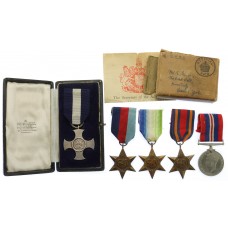WW2 Distinguished Service Cross Medal Group of Five - Temp. Lieutenant E. Benn, Royal Naval Volunteer Reserve, H.M.S. Violet
- Product Code: MM-5223
- Regiment: Royal Naval Volunteer Reserve
- Era: WW2 Availability: Out of Stock
-
Price: £1,875.00
A second world war DSC medal group for the sinking of U-641, awarded to Temporary Lieutenant Edward Benn, Royal Navy Volunteer Reserve.
Distinguished Service Cross (Dated 1945) unnamed as issued
1939-45 Star unnamed as issued
Atlantic Star unnamed as issued
Burma Star unnamed as issued
War Medal 1939-45 unnamed as issued
The DSC comes in original fitted case from Garrard & Co. Ltd and the WW2 medals come with box of issue addressed to Mr. E. Benn, The Old Hall, Knostrop, Leeds 1, Yorks and the entitlement slip.
The award of the DSC was published in the London Gazette 19 June 1945:
“For bravery, determination and devotion to duty whilst serving in H.M.S. Retalick and light coastal forces in operations against E-boats, enemy submarines and explosive motor boats.”
Seedie’s lists it as being awarded for “Hedgehog attack, enemy submarine Jan 44”
The official recommendation for the DSC states:
Temporary Lieutenant Edward Benn, R.N.V.R.
“This officer was ASCO during the attack and had been so for 20 months previously. During the time he has served under my command he has proved zealous, energetic and conscientious in the performance of his duties.
It is my considered opinion that due to the efficiency of the A/S Team, the accuracy and manner in which the ASDIC reports were passed to me during the submarine attack, all of which are this officer’s responsibility, the Commanding Officer of HMS VIOLET was able to fight his ship to gain the official assessment “Probably sunk”. (C in C W.A. 201156A/March refers).
Temporary Lieutenant Edward Benn, R.N.V.R. Is accordingly recommended for the award of a decoration such as My Lords, the Commissioners of the Admiralty may consider.”
U-641 was initially listed as “probably sunk” but it was later confirmed as lost with all hands on 19th of January 1944 following the attack by HMS Violet.
Lt. Benn was in charge of the ASDIC on HMS Violet, one of the small flower class Corvettes. At the time U-641 was sunk, HMS Violet was acting as one of the escorts for convoy OS.65/KMS.39.
On January 14th 1944 convoy OS.65/KMS.39 departed from Liverpool. It consisted of about fifty ships in total, although several of the ships (including the escort carrier HMS Fencer) scheduled to be part of the convoy did not join. The convoy was made up of two parts, the OS part would head for Freetown Sierra Leone and the KMS part for Gibraltar. Their initial progress would be together as they had to pass the German U-boat pens on the west cost of France. This would mean passing right through the U-boats backyard. On the 17h of January the convoy was spotted by a HE-177, and the warning flashed to the U-boats. Only one U-boat was in position to intercept the convoy, this was U-641.
On the 11th of December 1943, U-641 had departed St Nazaire for its fifth war patrol since entering service. So far the U-boat and its captain Horst Rendtel had not had any success in killing Allied shipping, they had been involved in three fights with aircraft however, and had damaged an Avenger flown off the USS Bouge in June 1943. Now they maneuvered towards the convoy reported by the HE-177.
In the outer ring of escorts steamed HMS Violet, a Flower class corvette. The Flower classes were tiny ships, with puny armament and low speed. They were considered horrible postings as they tended to get swamped in the open ocean and were permanently cold and damp. What they were was cheap, and able to carry anti-submarine weapons. Normally they would be expected to keep a submarine busy until the convoy had passed and then attempt to rejoin. When armed with just depth charges this was often all they could do. Even with ASDIC, in the final moments of an attack the contact would be lost, and the final aiming of the depth charges would have to be done by guesswork. HMS Violet's previous kill had been in conjunction with two destroyers, another corvette and a minesweeper. It had taken all five ships to kill the submarine U-651 in June 1941. Indeed, its suggested the ratio of depth charges used to submarines killed could be as high as 60:1.
However, HMS Violet was on her first cruise after a refit, where she had been fitted with a Hedgehog mortar. This was a multi-barreled spigot mortar which threw the projectile ahead of the ship. This allowed the ship to keep track of its target on ASDIC while making its attack run. In addition, the hedgehog projectiles would only detonate when they touched the hull of the submarine, meaning an almost guaranteed kill. The ratio for Hedgehogs was close to 6:1.
On the evening of the 19th of January 1944 HMS Violet would face off against U-641. HMS Violet’s captain, Lieutenant-Commander Charles Napier Stewart, filed a report on the subject:
At 19:01, while in position CC, a doubtful echo was heard on ASDIC that might have been a submarine. The range was given as 1,900 yards. A/B Pearson was trained to stand ASDIC watches, however he was not fully qualified, hence the doubtful nature of the report. The order was given for HMS Violet to reduce speed to 5 knots, and she began to close. Meanwhile a fully trained crewman was brought to the ASDIC controls. By 19:02 the echo was confirmed as a submarine and it was now at 1,800 yards. When the range had dropped to 1,300 yards the submarine started to turn away and was making a speed of about 2 knotts. Slowly HMS Violet closed the distance, and at 19:12 speed was increased to 8 knotts, and steering given over to ASDIC control (Lt Benn) and Violet started her first attack run.
At 19:17 and 45 seconds, at a range of 220 yards the Hedgehog was fired, lobbing the ungainly projectiles into the air, to splash down into the water ahead of the corvette. Some sixteen seconds later two explosions were heard, followed two seconds later by another one.
During the last few seconds of the attack the ASDIC contact was degrading from the submarine’s wake, and as HMS Violet passed over the attack point she lost contact, and a calcium flare was dropped overboard to mark the position. The contact was regained at 19:21, although the contact was described as 'woolly' due to the disturbance in the water from the explosions. By 19:28 HMS Violet had reached 1,500 yards distance and turned for another attack run. As contact had been lost, the ships plotting room had maintained the location of the last position of U-641. As the corvette approached at 19:35 an oil patch was sighted in the location near the flare. It was decided not to make a second attack, although Lt-Cmdr Stewart admits later this was a mistake.
As HMS Violet passed over the attack site a huge explosion was heard by all on deck, the engine room and on ASDIC. The engine room also reported noises caused by breaking up, however this was not confirmed by the ASDIC operator as it was now blinded by the wake. On the third pass the oil slick now measured about 277m by 185m, and there was a strong smell of oil. A sample was taken by dragging a canvas sack through the slick.
HMS Violet then linked up with HMS Rosebay and they began a box search of the area, some six hours later at 01:52 there was a mix up in signals and the search was ended prematurely. Not that it mattered in this case, U-641 had been lost with all hands.
T/Lt Benn serve on HMS Violet from 1942 – 1946. During this time the ship sailed on convoys to Gibraltar, sank U-641 in the North Atlantic, and was in convoys to and from Aden, Bombay, Hormuz, Colombo. Chittagong, Calcutta,Madras, Vizagpanam, Karachi and was in Oman, Colombo and Madagascar.
We take great pride in our stock and will always strive to bring you genuine items. All our items are carefully checked to make sure they are authentic original pieces.
Having worked in the field for many years we appreciate that there can occasionally be differences of opinion. This is why we have a no quibble returns policy on ALL items. If you want to return any purchase, for whatever reason, we will issue a full refund including your postage costs.
PAYMENT:
We accept payment by:
Credit and debit cards
Cash (any currency)
U.K. postal orders
Sterling cheques
PayPal
Exchange of goods
SHIPPING:
Our standard shipping costs apply on almost all of our items. The prices are as follows:
UK Standard Delivery - £3.45
UK Special Delivery - £7.95
Europe Priority Airmail - £9.95
Rest of World Priority Airmail - £11.45
Some large/heavy items may incur extra shipping costs. This will be clearly marked in the description and all prices will be shown before any payment is taken.
For more information on payment and shipping please click here
Tags: WW2 Medals, Gallantry Medals, British Medals, Naval Medals, HMS Violet, World War Two, WWII, RNVR, DSC












-page-00172-74x74.jpg)
